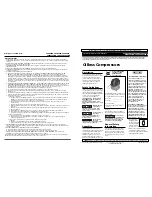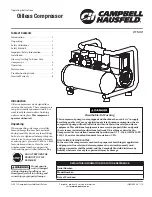
Model T32335 (Mfd. Since 11/20)
-27-
Review the troubleshooting procedures in this section if a problem develops with your machine. If you need
replacement parts or additional help with a procedure, call our Technical Support.
Note: Please gather the
serial number and manufacture date of your machine before calling.
SECTION 7: SERVICE
Troubleshooting
Motor & Electrical
Symptom
Possible Cause
Possible Solution
Machine does
not start, or
power supply
breaker
immediately
trips after
startup.
1. Tank already pressurized.
2. Incorrect power supply voltage or circuit size.
3. Pressure switch cut-in/cut-out settings have
been adjusted incorrectly.
4. Power supply circuit breaker tripped or fuse
blown.
5. Tripped thermal overload in motor,
compressor is exceeding its duty cycle.
6. Wiring broken, disconnected, or corroded.
7. Check valve components are dirty/damaged.
8. Pressure switch at fault.
9. Motor or motor bearings at fault.
1. Motor will not start if tank is fully pressurized.
2. Ensure correct power supply and circuit size
(
Page 11).
3. Adjust settings (
Page 31). Do not exceed cut-in/cut-
out pressures listed on data sheet (
Page 6) or inside
pressure switch.
4. Ensure circuit is free of shorts. Reset circuit breaker or
replace fuse.
5. Reduce load on compressor and allow longer cool
down periods.
6. Fix broken wires or disconnected/corroded
connections.
7. Clean/replace check valve components (
Page 30).
8. Turn compressor
OFF, disconnect from power, and
empty tank. DO NOT USE until switch is replaced.
9. Replace motor.
Machine
stalls or is
underpowered.
1. Air filter dirty/clogged.
2. Pump/motor have restricted airflow.
3. Pressure switch cut-in/cut-out settings have
been adjusted incorrectly.
4. Tripped thermal overload in motor,
compressor is exceeding its duty cycle.
5. Run capacitor at fault.
6. Extension cord too long.
7. Check valve components are dirty/damaged.
8. Motor or motor bearings at fault.
9. Worn valves or rings/compressor pump at
fault.
1. Replace air filter (
Page 24).
2. Clean cylinder fins, motor fan, and vent area.
3. Adjust settings (
Page 31). Do not exceed cut-in/cut-
out pressures listed on data sheet (
Page 6) or inside
pressure switch.
4. Reduce load on compressor and allow longer cool
down periods.
5. Test/repair/replace.
6. Move machine closer to power supply; use shorter
extension cord.
7. Clean/replace check valve components (
Page 30).
8. Replace motor.
9. Rebuild/replace.
Machine has
vibration or
noisy operation.
1. Motor or component loose.
2. Suction feet loose.
3. Motor fan rubbing on fan cover.
4. Motor bearings at fault.
5. Compressor pump at fault.
1. Replace damaged or missing bolts/nuts or tighten if
loose.
2. Tighten bolts.
3. Fix/replace fan cover; replace loose/damaged fan.
4. Test by rotating shaft; rotational grinding/loose shaft
requires bearing replacement.
5. Compressor piston rod/bearings/crankshaft is worn.
Rebuild or replace pump.
Summary of Contents for QUIET Series
Page 40: ......












































